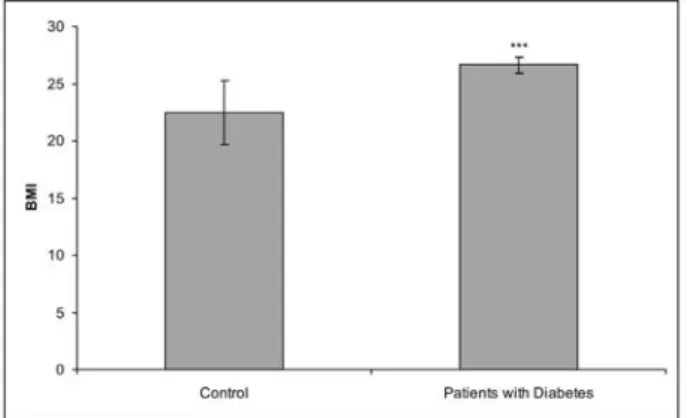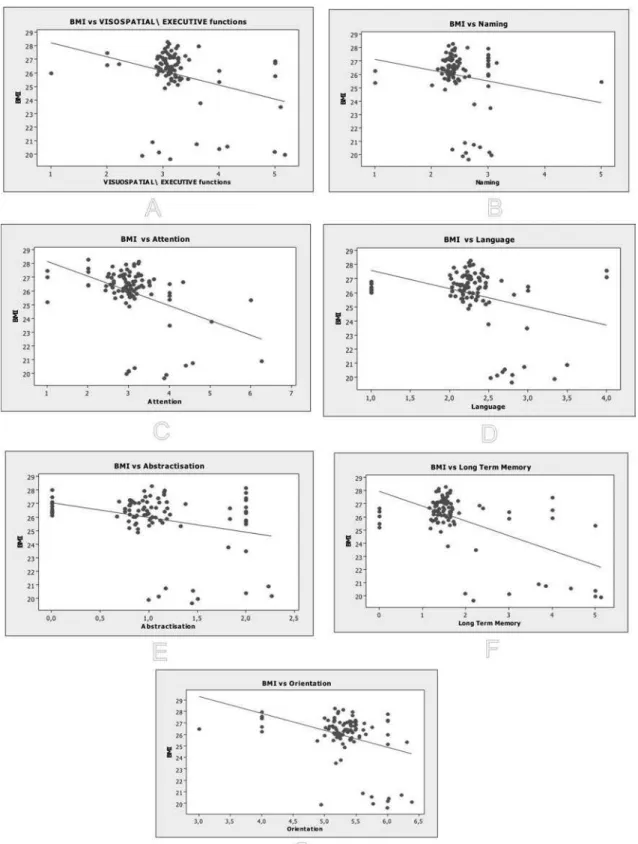347
RELEVANCE OF THE BODY MASS INDEX IN THE COGNITIVE STATUS OF DIABETIC PATIENTS WITH DIFFERENT ALCOHOL-DRINKING PATTERNS
IONELA LACRAMIOARA SERBAN1*,CRISTINA TOARBA1, SIMONA HOGAS1, A. COVIC1,
A. CIOBICA2,3, ROXANA CHIRITA1 and MARIANA GRAUR1
1“Grigore T. Popa” University of Medicine and Pharmacy, 700115, Iaşi, Romania 2 “Alexandru Ioan Cuza” University, Iaşi, 700506, Romania
3 Center of Biomedical Research of the Romanian Academy, 700506 Iaşi Branch, Romania
Abstract - Nowadays the general relevance of alcohol consumption in diabetes is extremely controversial. here are recent reports that alcohol consumption could result in a decreased incidence of diabetes, as well as other studies demonstrat-ing a positive association between alcohol consumption and type 2 diabetes; there are also reports argudemonstrat-ing for an inverse association between the two or for no correlation at all. he diferent results obtained in these studies could be explained by the existence of several confounders that could inluence the outcome of the aforementioned studies. In this paper, we studied the possible relevance of BMI as a confounder in the relationship between alcohol consumption in diabetes and cognitive function, by analyzing the correlations between BMI values in diabetic patients with diferent alcohol drinking patterns and the subdomains from some main psychometric tests, such as MMSE (Mini-Mental State Examination) and MOCA (Montreal Cognitive Assessment). Our results provide evidence for BMI as a possible confounder of the relation-ship between alcohol consumption in diabetes and cognitive function. We found a signiicant increase (p<0.0001) in BMI values in patients with diabetes compared to our control group. Most importantly, signiicant correlations between BMI parameters in alcohol-consuming diabetic patients and most of the subdomains for psychometric testing.
Key words: Diabetes, alcohol, cognitive, body mass index
INTRODUCTION
Considering alcohol usage is such widespread social aspect of modern life, there is an increased awareness regarding the possible efects of alcohol consump-tion in the progression and complicaconsump-tions of diabetes (Baliunas et al., 2009; Carlsson et al., 2003; Conigrave et al., 2001; Wei et al., 2000).
he general relevance of alcohol consumption in diabetes is extremely controversial, considering that there are recent reports describing that moder-ate alcohol consumption could be associmoder-ated with a decreased incidence of type 2 diabetes (Zilkens et al.,
2003; Howard et al., 2004), as well as a variety of other studies demonstrating a positive association between drinking alcohol and type 2 diabetes (Heianza et al., 2013; Ajani et al., 2000; Rimm et al., 1995; Perry et al., 1995). In addition, several reports demonstrate an inverse association between the two (Carlsson et al., 2005; Holbrook et al., 1990; Tsumura et al., 1999). Moreover, there are studies stating that there is no association between alcohol consumption and the incidence of diabetes (Wei et al., 2000; Ohlson et al., 1998; Hodge et al., 1993).
con-aforementioned apparent protective efect of alcohol in diabetic pathology (Stampfer et al., 2008). hese aspects regarding the BMI were never tested in the light of the correlations that might exist between dia-betic pathology, alcohol consumption and cognitive function.
Our objective was to investigate the degree of cognitive decline in alcohol-consuming patients with diabetes. Our analysis was initially focused on the relevance of BMI in these correlations, regardless of the drinking habits of the patients. his paper will extensively present the correlations between BMI values in patients and the subdomains from some main psychometric tests, such as the MMSE (Mini-Mental State Examination) and MOCA (he Mon-treal Cognitive Assessment).
MATERIALS AND METHODS
Patients
his study was conducted according to provisions of the Helsinki Declaration and all the patients signed their consent for participation in this study. It con-sisted of 80 patients (39 females and 41 males; aged 61.2 years±4.7) with diabetes, and 14 healthy age-matched controls (8 females and 6 males; aged 59.5 years±5.8). Diabetes was diagnosed when fasting glycemia was ≥126 mg/dl. Patients were recruited from the University Hospital of Psychiatry “Socola”, Iaşi, Romania and they were chronic alcohol abus-ers, fulilling DSM diagnostic criteria of alcohol de-pendence. he healthy control subjects had diabetes excluded by blood samples. he demographic data of
P<0.05 were regarded as statistically signiicant. Pear-son’s correlation coeicient was used to evaluate the connection between the BMI values versus various subdomains of psychometric tests such as the MMSE and MOCA.
RESULTS
he initial analysis of the results included the BMI values in all patients. We observed a signiicant in-crease (p<0.0001) in BMI values in patients with dia-betes compared to our control group (Fig. 1).
When we analyzed the connections between BMI values and the results from the MMSE and MOCA tests, we found signiicant negative correlations for BMI vs. MMSE (n=95, r= -0.783, p< 0.0001) (Fig. 2) and for BMI vs. MOCA (n=95, r= -0.598, p< 0.0001) (Fig. 3).
In addition, we found signiicant negative cor-relations between the values of BMI and most of the subdomains of both MMSE – BMI vs. orienta-tion (n=95, r= -0.479, p< 0.0001) (Fig. 4A), BMI vs. attention (n=95, r= -0.516, p< 0.0001) (Fig. 4C), BMI vs. recent memory (n=95, r= -0.533, p< 0.0001) (Fig. 4D), and MOCA tests – BMI vs. visu-ospatial/executive functions (n=95, r= -0.312, p= 0.002) (Fig. 5A), BMI vs. attention (n=95, r= -0.417 , p< 0.0001) (Fig. 5C), BMI vs. language (n=95, r= -0.329 , p= 0.001) (Fig. 5D), BMI vs. abstractization (n=95, r= -0.313, p= 0.002) (Fig. 5E), BMI vs. long term memory (n=95, r= -0.577 , p< 0.0001) (Fig. 5F) and BMI vs. orientation (n=95, r= -0.376 , p< 0.0001) (Fig. 5G).
However, in the case of some subdomains from the MMSE test, we could not ind any signiicant correla-tions, such as in the case of BMI vs. short-term mem-ory (n=95, r= -0.133, p= 0.2) (Fig. 4B), BMI vs. lan-guage (n=95, r= -0.086 , p= 0.405) (Fig. 4E) and BMI vs. executive functions (n=95, r= -0.046 , p= 0.659) (Fig. 4F). In addition, we did not observe any correla-tions between BMI vs. naming (n=95, r= -0.175, p= 0.09) (Fig. 5B) and BMI values and the level of schol-arization, added or not, to the MOCA test: BMI vs. level of scholarization (n=95, r= -0.068, p= 0.512).
DISCUSSION
Our results provide evidence for the BMI as a pos-sible confounder of the relationship between alcohol consumption in diabetes and cognitive function. However, the present study was performed in dia-betic alcohol-consuming patients regardless of their drinking habits. More detailed data regarding how the exact amount of alcohol ingestion inluences dia-betic pathology and cognitive functions are under-way by our research group.
We have shown the possible correlation between BMI values and cognitive deicits as judged by scores of the MMSE and MOCA tests in diabetic patients with drinking habits. Moreover, we have demon-strated signiicant correlations between BMI val-ues and most of the subdomains from MMSE and MOCA tests. his is particularly important since the association of BMI with cognitive decline showed varying results with higher BMI and weight decline as risk factors for the cognitive impairment. hese diferences could be attributed to the age of the indi-viduals (Johnson et al., 2006; Kivipelto et al., 2001). Our diabetic patients had an average age of 61.2 years and increased BMI values compared to aged-matched controls.
Fig. 2. Correlation between the Body Mass Index (BMI) and Mini-Mental State Examination (MMSE) (n=95, r= -0.783, p< 0.0001).
Rasay et al., 2006), similar risk (Stewart et al., 2005) or decreased risk (Nourhash´emi et al., 2001; Luchs-inger et al., 2007) of high BMI and cognitive impair-ment were previously reported.
It seems that BMI could be an important factor in the correlations that appear between alcohol con-sumption, diabetic pathology and cognitive status. However, some recent studies state no diferences in relative risk reductions between individuals with low or high BMI, as in a meta-analysis regarding alco-hol as a risk factor for type 2 diabetes by Baliunas et al. (2009). hese aspects leave this subject open to further discussion and studies, and our group is al-ready working on how the amount on alcohol inges-tion and speciic drinking habits inluence diabetic pathology.
CONCLUSION
he results described herein provide evidence regard-ing BMI as a possible confounder between alcohol consumption in diabetes and cognitive functioning.
REFERENCES
Ajani, U.A., Hennekens, C.H., Spelsberg, A. and J.E. Manson
(2000). Alcohol consumption and risk of type 2 diabetes mellitus among US male physicians. Arch Intern Med160,
1025-1030.
Baliunas, D.O., Taylor, B.J., Irving, H., Roerecke, M., Patra, J., Mo-hapatra, S. and J.Rehm (2009). Alcohol as a risk factor for type 2 diabetes: A systematic review and meta-analysis.
Diabetes Care32, 2123-32.
Carlsson, S., Hammar, N., Grill, V. and J. Kaprio (2003). Alcohol consumption and the incidence of type 2 diabetes: a
20-body mass index and cognitive function in healthy mid-dle-aged men and women. Neurology67, 1208-1214.
Gustafson, D., Rothenberg, E., Blennow, K., Steen, B. and I. Skoog
(2003). An 18-year follow-up of overweight and risk of Al-zheimer disease. Arch Intern Med163, 1524-1528.
Heianza, Y., Arase, Y., Saito, K., Tsuji, H., Fujihara, K., Hsieh, S.D. et al (2013). Role of alcohol drinking pattern in type 2 diabetes in Japanese men: the Toranomon Hospital Health Management Center Study 11 (TOPICS11). Am J Clin Nutr97, 561-8.
Hodge, A.M., Dowse, G.K., Collins, V.R. and P.Z. Zimmet (1993). Abnormal glucose tolerance and alcohol consumption in three populations at high risk of non-insulin-dependent diabetes mellitus. Am J Epidemiol137, 178-189.
Holbrook, T.L., Barrett-Connor, E. and D.L. Wingard (1990). A prospective population based study of alcohol use and non-insulin-dependent diabetes mellitus. Am J Epidemiol
132, 902-909.
Howard, A.A., Arnsten, J.H. and M.N.Gourevitch (2004). Efect of alcohol consumption on diabetes mellitus. Ann Intern Med140, 211-219.
Johnson, D.K., Wilkins, C.H. and J.C. Morris (2006). Accelerated weight loss may precede diagnosis in Alzheimer disease.
Arch Neurol 63, 1312-7.
Kivipelto, M., Helkala, E.L., Laakso, M.P., Hänninen, T., Hal-likainen, M., Alhainen, K. et al. (2001). Midlife vascular risk factors and Alzheimer’s disease in later life: longitudi-nal, population based study. BMJ322, 1447-51.
Luchsinger, J.A. and Mayeux, R.(2007). Adiposity and Alzheim-er’s disease.Curr Alzheimer Res 4, 127-34.
Nourhashémi, F., Deschamps, V., Larrieu, S., Letenneur, L., Dar-tigues, J.F., Barberger-Gateau, P. et al. (2003). Personnes Agées Quid. Body mass index and incidence of dementia: the PAQUID study. Neurology60, 117-119.
(non-in-sulin-dependent) diabetes mellitus: thirteen and one-half years of follow-up of the participants in a study of Swedish men born in 1913. Diabetologia31, 798-805.
Perry, E., Wannamethee, S.G., Walker, M.K., homson, A.G., Whincup, P.H. and A.G. Shaper (1995). Prospective study of risk factors for development of non-insulin dependent diabetes in middle-aged British men. BMJ310, 560-564.
Rasay, G., Vreugdenhil, A. and G. Wilcock (2006). Obesity, ab-dominal obesity and Alzheimer disease. Dement Geriatr Cogn Disord22, 173-176.
Rimm, E.B., Chan, J., Stampfer, M.J., Colditz, G.A. and W.C. Wil-lett (1995). Prospective study of cigarette smoking, alcohol use, and the risk of diabetes in men. BMJ310, 555-559.
Stampfer, M.J., Colditz, G.A., Willett, W.C., Manson, J.E., Arky, R.A., Hennekens, C.H. et al. (1988). A prospective study of
moderate alcohol drinking and risk of diabetes in women.
Am J Epidemiol.128, 549-58.
Stewart, R., Masaki, K., Xue, Q.L., Peila, R., Petrovitch, H., White, L.R. et al. (2005). 32-year prospective study of change in body weight and incident dementia: the Honolulu-Asia Aging Study. Arch Neurol2, 55-60.
Tsumura, K., Kayashi, T., Suematsu, C., Endo, G., Fujii, S. and K. Okada (1999). Daily alcohol consumption and the risk of type 2 diabetes in Japanese men: the Osaka Health Survey.
Diabetes Care22, 1432-1437.
Wei, M., Gibbons, L.W., Mitchell, T.L., Kampert, J.B. and S.N. Blair (2000). Alcohol intake and incidence of type 2 diabe-tes in men. Diabetes Care. 23, 18-22.



